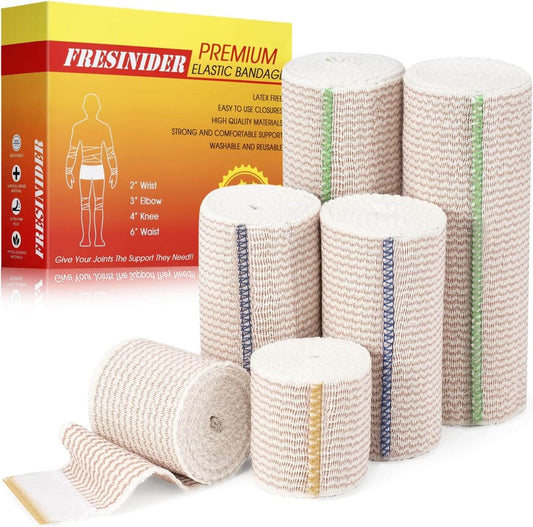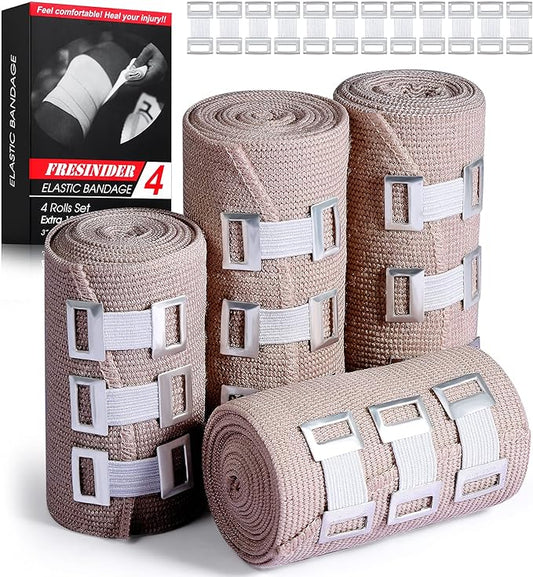A clear, practical guide to elastic (compression) bandages: what they are, how they work, when to use them, how to wrap safely, and whether to choose a Velcro or clip closure.
What Is an Elastic Bandage?
An elastic bandage is a stretchable compression wrap made of cotton or synthetic fibers. When applied correctly, it provides gentle, consistent pressure around an injured body part to help limit swelling and offer comfortable support to muscles and joints.
- Materials: Often cotton-based, breathable, and latex-free.
- Closures: Traditional clips or modern Velcro (hook-and-loop).
- Sizes: Common widths are 2", 3", 4", and 6" for wrists, ankles, knees, and thighs.

How Does an Elastic Bandage Work?
The bandage works by applying controlled compression to the affected area:
- Limit swelling: helps reduce fluid buildup after a sprain or strain.
- Support: stabilizes joints and soft tissues to reduce the risk of further injury.
- Comfort: can hold a cold pack or dressing in place during care.
Safety first: The wrap should feel snug, not tight. If you notice numbness, tingling, increasing pain, or discoloration, loosen it right away.
Velcro vs. Clips: Which Closure Fits Your Scenario?
| Feature | Velcro Bandage | Clips Bandage |
|---|---|---|
| Closure | Quick hook-and-loop fastener | Metal or plastic clips |
| Ease of Use | Easy, even with one hand | Requires precise placement |
| Security | Firm hold without pins | Clips may loosen with movement |
| Best For | Everyday users, athletes, quick application | Traditional users, budget focus |
Shop Elastic Bandage with Velcro Shop Elastic Bandage with Clips
When to Use an Elastic Bandage
- Sprains & strains: provides compression and stability.
- Sports recovery: supports muscles after activity.
- Post-procedure care: helps manage temporary swelling.
- First aid kits: versatile for home, travel, and teams.

How to Apply an Elastic Bandage (Step by Step)
- Elevate the limb if possible and relax the muscles.
- Start wrapping at the area farthest from the heart (e.g., toes → ankle).
- Overlap each layer by about half the bandage width; keep the roll close to the skin.
- Maintain even pressure—snug, not tight; you should be able to slip two fingers under the wrap.
- Secure with Velcro or clips, then check circulation (skin warm and pink, normal sensation).
Safety & When to Seek Care
- Do not wear the wrap overnight unless a clinician tells you to.
- Rewrap every few hours to maintain proper compression.
- If you feel numbness, tingling, increasing pain, or see blue/purple skin, loosen immediately.
- Elastic bandages offer support and are not a substitute for professional diagnosis or treatment.
Care & Cleaning
- Hand-wash with mild soap; rinse thoroughly.
- Air dry flat; avoid high heat or tumble dryers.
- Hook-and-loop grip may diminish with repeated washing; replace when needed.
FAQs
How long should I wear an elastic bandage?
Several hours at a time during the day. Remove at night and rewrap as needed.
Can I sleep with it on?
Generally not recommended unless your healthcare professional advises otherwise.
Which closure is better: Velcro or clips?
Velcro is quick and convenient; clips are classic and budget-friendly. Choose based on convenience, activity, and preference.
Can I use it with ice?
Yes. Wrap over a cloth layer to hold a cold pack in place; avoid direct ice-to-skin contact.
Shop FRESINIDER Velcro Bandage Shop FRESINIDER Clips Bandage





